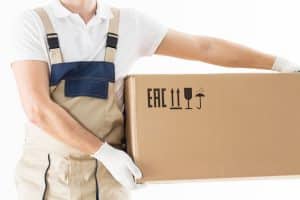Packing for a move can feel overwhelming, especially if it’s not something you do often. However, with the right strategies and techniques, you can make the process smoother and more efficient. Organizational tips for packing can save you time, reduce stress, and even help prevent lost or misplaced items during the move. Below, we’ll cover essential tips on creating a packing timeline, labeling and categorizing boxes, and keeping an inventory for better tracking. These practices will not only streamline your move but also ensure that everything arrives safely and in order.
1. Creating a Packing Timeline
One of the most critical aspects of packing is timing. A packing timeline helps you break down the daunting task into manageable steps. To ensure you’re not scrambling at the last minute, begin by setting a clear timeline for when each part of the packing process needs to occur.
Step 1: Start Early
The earlier you start packing, the more manageable the task will feel. Ideally, begin at least 3-4 weeks before the move, especially if you’re moving a larger household. For smaller moves, 1-2 weeks might suffice. Starting early allows you to pack systematically without feeling rushed.
Step 2: Prioritize and Organize
Create a packing schedule that focuses on one room or category of items at a time. Start with the least essential items—things you don’t need on a daily basis, such as seasonal clothes or decor—and gradually move on to more frequently used items as the move date nears. By prioritizing the packing process, you can avoid feeling overwhelmed by doing everything all at once.
Step 3: Set Milestones
Divide the timeline into weekly or daily goals. For example, week one might involve packing up the attic or storage areas, week two could be dedicated to the kitchen, and week three to packing up your living spaces and bedrooms. Make sure you give yourself enough time to get each section done, but don’t be afraid to adjust your timeline if necessary.
Step 4: Allocate Time for Unpacking
Packing isn’t the only part of the process that requires attention. Setting a timeline for unpacking once you arrive at your new location is equally as important. Prioritize getting essential items unpacked first, such as toiletries, bedding, and kitchen essentials, and then gradually move to other areas.
2. Labeling and Categorizing Boxes
Proper labeling and categorizing are essential for ensuring that your boxes can be easily located and unpacked at your new home. Effective labeling not only helps you avoid confusion during the move, but it also reduces the likelihood of items getting misplaced.
Step 1: Label Every Box
Make sure each box is labeled clearly with its contents and the room it belongs in. Use large, bold markers to write on the sides of boxes so that the labels are visible even when stacked. Don’t just label boxes with vague terms like “miscellaneous” or “stuff”—this won’t help much when you’re trying to unpack. Instead, be specific, such as “living room books” or “kitchen utensils.”
Step 2: Color-Code Boxes
One of the most effective organizational tips for packing is using a color-coding system. Assign a specific color to each room and mark boxes with corresponding colored labels or tape. For instance, all kitchen boxes might be marked with red tape, bedroom boxes with blue, and bathroom boxes with green. This color-coded system makes it easy to visually distinguish between the different boxes and helps movers know where to place each one.
Step 3: Use Labeling Codes
In addition to color coding, you can also use a numerical or alphabetical system to categorize your boxes. For example, a system like “B1” for the first box in the bedroom or “K3” for the third kitchen box provides clarity and order. This method is especially helpful when you have many boxes from one room or category, as it allows for even more precise tracking.
Step 4: Don’t Forget Fragile Items
Fragile items require special attention. Make sure you clearly mark boxes containing breakable items with “Fragile” and, ideally, include a specific description of the contents, such as “Fragile: Wine Glasses” or “Fragile: China Plates.” In addition, consider using extra padding, like bubble wrap or packing paper, to protect delicate items.
3. Keeping an Inventory for Better Tracking
An inventory system is an often overlooked but highly beneficial part of organizing your move. By keeping a detailed record of everything you’re packing, you can track each box’s contents and reduce the chances of losing important items.
Step 1: Create an Inventory List
Before you begin packing, create an inventory list for each room. Number each box as you pack it and make a corresponding list of the contents. For example, “Box 1: 10 dishes, 5 bowls, 3 mugs, and 1 teapot.” You can easily keep this list on a piece of paper or in a spreadsheet, and having this reference on hand when unpacking will make the process so much easier.
Step 2: Use a Digital Inventory Tool
For added convenience, consider using a moving application or digital spreadsheet to keep track of your inventory. Many apps allow you to take photos of the contents of each box and add descriptions, making it easier to reference when you need to locate specific items. Some apps even allow you to share your inventory with movers, ensuring that they know exactly where everything is.
Step 3: Number Your Boxes and Track Them
As mentioned earlier, labeling boxes with numbers (such as “Box 1,” “Box 2,” etc.) will help you easily cross-check with your inventory list. As you pack, update the list to reflect what’s in each box. After the move, use the list to check off each box as it’s unloaded. This ensures nothing gets left behind.
Step 4: Mark Essential Items Separately
While an inventory system tracks everything, it’s crucial to make sure that you can easily access essential items. Consider packing a “first-night” box with items like toiletries, a change of clothes, and important documents, and label it clearly as “Essential” or “Open First.” This box should be one of the last ones packed and the first one you unpack at your new home.
Moving doesn’t have to be stressful if you take the time to plan and organize your packing process. By creating a packing timeline, labeling and categorizing your boxes effectively, and keeping an inventory of your items, you can ensure a smooth transition to your new home. Whether you’re moving locally or long distance, these organizational tips will help keep everything in order and reduce the chaos of packing. And if you need help with the heavy lifting, don’t hesitate to consider professional movers who can assist with the packing and ensure that your belongings are handled with care. Happy moving!

- Use clear plastic bins.
Store decorations and holiday items in clear bins instead of cardboard boxes. This way, you can easily see what’s inside without digging through everything.
- Wrap delicate ornaments.
Use bubble wrap, tissue paper, or even socks to protect fragile ornaments. Pack them snugly to avoid shifting during the move.
- Label boxes clearly.
Write “Holiday Decorations” on all sides of the box and add details like “Tree Lights” or “Stockings” so you know exactly what’s inside.
- Pack wrapping supplies together.
Keep gift wrap, tape, scissors, and ribbon in one box. Consider using a gift wrap storage bag to keep rolls from getting crushed.
- Secure string lights.
Wrap lights around a piece of cardboard or an empty paper towel roll to keep them tangle-free.
- Pack a “Holiday Essentials” box.
If you plan to decorate shortly after moving in, pack your favorite or most-used decorations in one box for easy access.
- Store candles carefully.
Avoid temperature-sensitive spots like unheated garages during transit to prevent candles from melting or cracking. Wrap them individually to keep them from scratching or breaking.
- Use soft items for padding.
Wrap decorations in holiday towels, blankets, or stockings to save space and add extra cushioning.
- Pack early.
Start packing holiday items you won’t need right away, like outdoor lights or seasonal dinnerware, to reduce stress closer to moving day.
- Take photos before packing.
Snap pictures of your decorated tree or displays so you can easily recreate the same setup in your new home.
Don’t Forget to Check In With Your Mover About the Weather.
Winter weather is no joke, so don’t forget to touch base with your movers as the big day gets closer. Ask them what they do if snow or ice shows up.
Do they reschedule, delay, or have tricks to keep things moving? If a storm’s on the way, they might suggest adjusting the time or taking a different route.
If you’re handling the move yourself, stay on top of the forecast. Be ready with snow shovels, ice melt, and furniture covers to keep your stuff (and yourself) safe.
A quick chat with your movers or some weather prep on your end can make sure nothing gets in the way of your holiday move!
Make Your Holiday Move Easy.

Frequently Asked Questions
What is the average long-distance moving cost?
The average cost ranges from $2,500 to $5,000, depending on the distance, size of your home, and services needed.
How can I find the cheapest moving truck rental long distance?
Compare rates from a few companies, including People-Move Moving. Book early and avoid peak days to save.
Where can I get long-distance moving quotes instantly?
Just call People-Move Moving to get instant moving quotes.
How much do moving companies long distance cost, and how can I save?
Cost depends on the size and distance of your move. Save by downsizing, preparing early, and moving during off-peak times.




